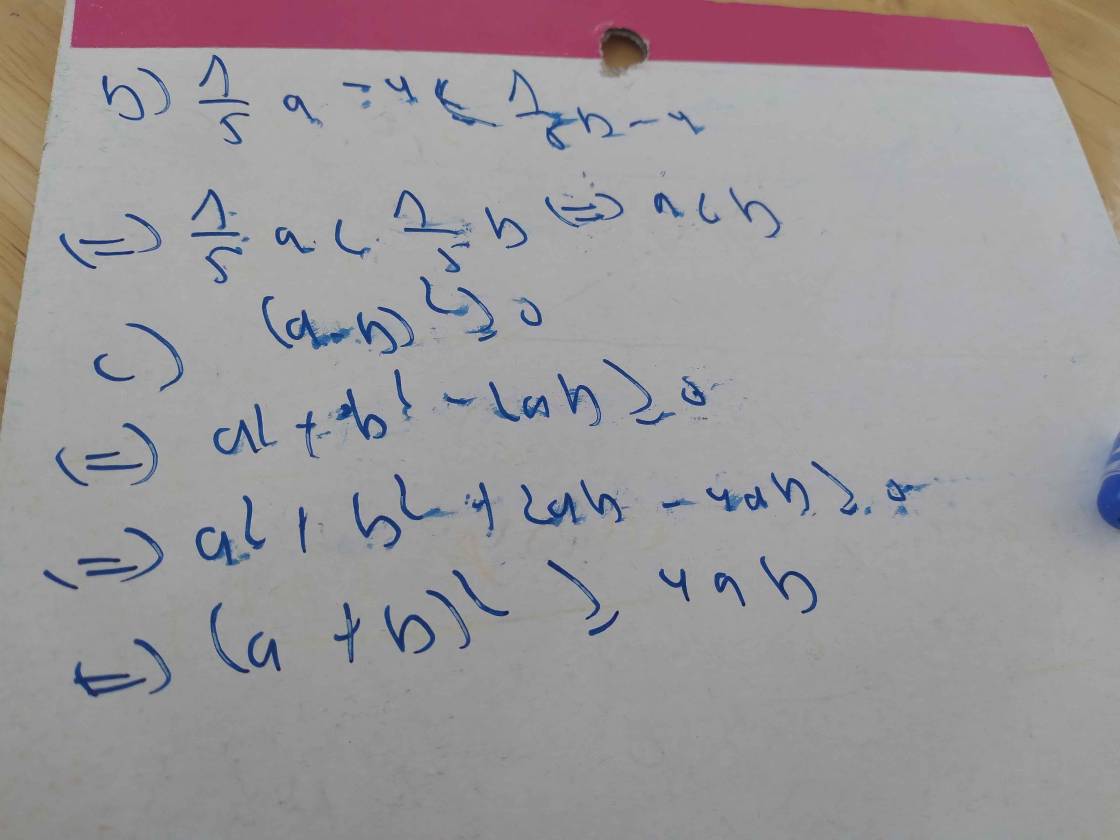

Hãy nhập câu hỏi của bạn vào đây, nếu là tài khoản VIP, bạn sẽ được ưu tiên trả lời.



a) Ta có :
5x - 2 =< 2x +8
<=> 5x - 2x =< 8 + 2
<=> 3x =< 10
<=> 3x. 1/3 =< 10.1/3
<=> x =< 10/3
Vậy S = ( 10/3 )
b) Ta có :
1/5a - 4 < 1/5b - 4
<=> 1/5 -4 + 4 < 1/5 - 4 + 4 ( cộng 4 )
<=> 1/5a < 1/5b
=> 1/5a.5 < 1/5b.5 ( nhân 5 )
<=> a < b
c ) ( a + b )2 ≥ 4ab
Ta có :
Vế trái : ( a + b )2
= a2 - 2ab + b2 + 4ab
= ( a - b )2 + 4ab
mà ( a - b )2 ≥ 0
=> ( a - b )2 + 4ab ≥ 0 + 4ab
<=> ( a + b )2 ≥ 4ab ( đpcm ! )

Bài 2:
A = (a+b)(1/a+1/b)
Có: \(a+b\ge2\sqrt{ab}\)
\(\frac{1}{a}+\frac{1}{b}\ge2\sqrt{\frac{1}{ab}}\)
=> \(\left(a+b\right)\left(\frac{1}{a}+\frac{1}{b}\right)\ge2\sqrt{ab}.2\sqrt{\frac{1}{ab}}=4\)
=> ĐPCM
1.b)
Pt (1) : 4(n + 1) + 3n - 6 < 19
<=> 4n + 4 + 3n - 6 < 19
<=> 7n - 2 < 19
<=> 7n - 2 - 19 < 0
<=> 7n - 21 < 0
<=> n < 3
Pt (2) : (n - 3)^2 - (n + 4)(n - 4) ≤ 43
<=> n^2 - 6n + 9 - n^2 + 16 ≤ 43
<=> -6n + 25 ≤ 43
<=> -6n ≤ 18
<=> n ≥ -3
Vì n < 3 và n ≥ -3 => -3 ≤ n ≤ 3.
Vậy S = {x ∈ R ; -3 ≤ n ≤ 3}

Bài 2:
Đặt \(2017-x=a;2019-x=b;2x-4036=c\)
\(\Rightarrow a+b+c=0\)
Do \(a+b+c=0\Rightarrow a+b=-c\Leftrightarrow\left(a+b\right)^3=-c^3\)
Có : \(a^3+b^3+c^3=\left(a+b\right)^3-3ab\left(a+b\right)+c^3=-c^3-3ab.\left(-c\right)+c^3=3abc\)
Do \(\left(2017-x\right)^3+\left(2019-x\right)^3+\left(2x-4036\right)^3=0\)
\(\Rightarrow3\left(2017-x\right)\left(2019-x\right)\left(2x-4036\right)=0\)
\(\Leftrightarrow\left[{}\begin{matrix}2017-x=0\\2019-x=0\\2x-4036=0\end{matrix}\right.\Leftrightarrow\left[{}\begin{matrix}x=2017\\x=2019\\x=2018\end{matrix}\right.\)

1. (a+b)^2 ≥ 4ab
<=> a2+2ab+b2≥ 4ab
<=> a2+2ab+b2-4ab≥ 0
<=> a2-2ab+b2≥ 0
<=> (a-b)^2 ≥ 0 ( luôn đúng )
2. a^2 + b^2 + c^2 ≥ ab + bc + ca
<=> 2a^2 + 2b^2 + 2c^2 ≥ 2ab + 2bc + 2ca
<=> 2a^2 + 2b^2 + 2c^2 - 2ab - 2bc - 2ca ≥ 0
<=> (a^2- 2ab+b^2) + (b^2-2bc+c^2) + (c^2-2ca+a^2) ≥ 0
<=> (a-b)^2 + (b-c)^2 + (c-a)^2 ≥ 0 ( luôn đúng)

3:
a: =>x=0 hoặc x+5=0
=>x=0 hoặc x=-5
b: =>x^2=4
=>x=2 hoặc x=-2
c: =>(x-5)(2x+1+x+6)=0
=>(x-5)(3x+7)=0
=>x=5 hoặc x=-7/3
1.
a. 2x - 6 > 0
\(\Leftrightarrow\) 2x > 6
\(\Leftrightarrow\) x > 3
S = \(\left\{x\uparrow x>3\right\}\)
b. -3x + 9 > 0
\(\Leftrightarrow\) - 3x > - 9
\(\Leftrightarrow\) x < 3
S = \(\left\{x\uparrow x< 3\right\}\)
c. 3(x - 1) + 5 > (x - 1) + 3
\(\Leftrightarrow\) 3x - 3 + 5 > x - 1 + 3
\(\Leftrightarrow\) 3x - 3 + 5 - x + 1 - 3 > 0
\(\Leftrightarrow\) 2x > 0
\(\Leftrightarrow\) x > 0
S = \(\left\{x\uparrow x>0\right\}\)
d. \(\dfrac{x}{3}-\dfrac{1}{2}>\dfrac{x}{6}\)
\(\Leftrightarrow\dfrac{2x}{6}-\dfrac{3}{6}>\dfrac{x}{6}\)
\(\Leftrightarrow2x-3>x\)
\(\Leftrightarrow2x-3-x>0\)
\(\Leftrightarrow x-3>0\)
\(\Leftrightarrow x>3\)
\(S=\left\{x\uparrow x>3\right\}\)
2.
a.
Ta có: a > b
3a > 3b (nhân cả 2 vế cho 3)
3a + 7 > 3b + 7 (cộng cả 2 vế cho 7)
b. Ta có: a > b
a > b (nhân cả 2 vế cho 1)
a + 3 > b + 3 (cộng cả 2 vế cho 3) (1)
Ta có; 3 > 1
b + 3 > b + 1 (nhân cả 2 vế cho 1b) (2)
Từ (1) và (2) \(\Rightarrow\) a + 3 > b + 1
c.
5a - 1 + 1 > 5b - 1 + 1 (cộng cả 2 vế cho 1)
5a . \(\dfrac{1}{5}\) > 5b . \(\dfrac{1}{5}\) (nhân cả 2 vế cho \(\dfrac{1}{5}\) )
a > b
3.
a. 2x(x + 5) = 0
\(\Leftrightarrow\left[{}\begin{matrix}2x=0\\x+5=0\end{matrix}\right.\) \(\Leftrightarrow\left[{}\begin{matrix}x=0\\x=-5\end{matrix}\right.\)
\(S=\left\{0,-5\right\}\)
b. x2 - 4 = 0
\(\Leftrightarrow x\left(x-4\right)=0\)
\(\Leftrightarrow\left[{}\begin{matrix}x=0\\x-4=0\end{matrix}\right.\Leftrightarrow\left[{}\begin{matrix}x=0\\x=4\end{matrix}\right.\)
\(S=\left\{0,4\right\}\)
d. (x - 5)(2x + 1) + (x - 5)(x + 6) = 0
\(\Leftrightarrow\left(x-5\right)\left(2x+1+x+6\right)=0\)
\(\Leftrightarrow\left(x-5\right)\left(3x+7\right)=0\)
\(\Leftrightarrow\left[{}\begin{matrix}x-5=0\\3x+7=0\end{matrix}\right.\Leftrightarrow\left[{}\begin{matrix}x=5\\x=\dfrac{-7}{3}\end{matrix}\right.\)
\(S=\left\{5,\dfrac{-7}{3}\right\}\)

Bài 2:
a) Áp dụng BĐT AM - GM ta có:
\(\dfrac{1}{4}\left(\dfrac{1}{a}+\dfrac{1}{b}\right)=\dfrac{1}{4a}+\dfrac{1}{4b}\) \(\ge2\sqrt{\dfrac{1}{4^2ab}}=\dfrac{2}{4\sqrt{ab}}=\dfrac{1}{2\sqrt{ab}}\)
\(\ge\dfrac{1}{a+b}\) (Đpcm)
b) Trừ 1 vào từng vế của BĐT ta được BĐT tương đương:
\(\left(\frac{x}{2x+y+z}-1\right)+\left(\frac{y}{x+2y+z}-1\right)+\left(\frac{z}{x+y+2z}-1\right)\le\frac{-9}{4}\)
\(\Leftrightarrow-\left(x+y+z\right)\left(\frac{1}{2x+y+z}+\frac{1}{x+2y+z}+\frac{1}{x+y+2z}\right)\le-\frac{9}{4}\)
\(\Leftrightarrow\left(x+y+z\right)\left(\frac{1}{2x+y+z}+\frac{1}{x+2y+z}+\frac{1}{x+y+2z}\right)\ge\frac{9}{4}\)
Áp dụng BĐT phụ \(\dfrac{1}{a}+\dfrac{1}{b}+\dfrac{1}{c}\ge\dfrac{9}{a+b+c}\) ta có:
\(\dfrac{1}{2x+y+z}+\dfrac{1}{x+2y+z}+\dfrac{1}{x+y+2z}\)
\(\ge\dfrac{9}{2x+y+z+x+2y+z+x+y+2z}=\dfrac{9}{4\left(x+y+z\right)}\)
\(\Leftrightarrow\left(x+y+z\right)\left(\frac{1}{2x+y+z}+\frac{1}{x+2y+z}+\frac{1}{x+y+2z}\right)\ge\frac{9}{4}\)
\(\Leftrightarrow\dfrac{x}{2x+y+z}+\dfrac{y}{x+2y+z}+\dfrac{z}{x+y+2z}\le\dfrac{3}{4}\) (Đpcm)
Bài 1:
Áp dụng BĐT Cauchy-Schwarz dạng Engel ta có:
\(VT\ge\dfrac{\left(a+b\right)^2}{a-1+b-1}=\dfrac{\left(a+b\right)^2}{a+b-2}\)
Nên cần chứng minh \(\dfrac{\left(a+b\right)^2}{a+b-2}\ge8\)
\(\Leftrightarrow\left(a+b\right)^2\ge8\left(a+b-2\right)\)
\(\Leftrightarrow a^2+2ab+b^2\ge8a+8b-16\)
\(\Leftrightarrow\left(a+b-4\right)^2\ge0\) luôn đúng